There is a moment, in the millennial history of an institution such as the Church, in which the choice of a name is not only a personal or symbolic act, but a declaration of intent, a programmatic manifesto, a seal of one’s own magisterium Petrine. This is what happened with the election to the papal throne of Robert Francis Prevost, who chose to be called Leo XIV. It is not a random choice, and it has never been in the history of the community of the faithful: the papal names bear precise inheritance with them, evoke models, schools of thought, seasons of the Church and the world. In the case of Leone XIV, the reference is direct, declared, explicit: Leo XIII, aka Vincenzo Gioacchino Pecci, author in 1891 of the famous encyclical Rerum novarumpromulgated on May 15, 1891, 134 years ago. And here it is better to stop a moment. Because, as historians know well, it is never clear if you do not have the patience to go back, in time and in contexts.
At the end of the nineteenth century Europe is not just a continent: it is a laboratory in full boiling. The colonial empires are in the midst of their expansion, the unification of Italy was recently made, the papacy lost the temporal power after the breach of Porta Pia in 1870, and Pope Pius IX retired symbolically within the Vatican walls, proclaiming himself “prisoner”. But outside those walls, the story runs fast. The second industrial revolution is being made: large steelworks are born, electricity, telegraph, transport are spread. The cities swell, the countryside empties, the workers pour into the factories, often in inhuman conditions. Women earn half of the already miserable men’s wages, the children, who crowd the factories attached to the frames instead of going to school, half of that of women. Pius IX is considered a traditionalist, after the initial openings that had thrilled the Risorgimento. He was attributed to the joke (probably never said, but significant of the climate) “Chemin de Fer, Chemin d’Efer”, which compares the development of the railways to the devil.
It is in this context that the pontificate of Leo XIII, a successor of Pius IX, proves to be extraordinarily modern, in the historical sense of the term. Why modernin those years, it is not a reassuring word: it is the sign of a turbulent era, marked by deep social injustices, by a growing split between classes and by the spread of ideologies that question the established order. Socialism, anarchy, Marxism make proselytes among the workers, while the Church, for centuries allied of the thrones, risks being cut out of what is becoming the real epochal question: the social question.
Here then comes the Rerum novarumwhich is not only a doctrinal document, but a real raid of the Church in modernity. It is an encyclical that, for the first time, addresses the problem of dignity of work In new, clear, courageous terms. Leo XIII does not just see: it takes a position. He denounces the exploitation, claims the right to a right salary, recognizes the legitimacy of the workers’ associations. In essence, he states a principle that today seems obvious to us, but which at the time was revolutionary: The worker is not a commodity.
And be careful: it is not an opening to socialism. On the contrary, Leo XIII, the pope who appears for the first time in a video in the history of the Church (and among the first in the history of cinema since the times of the Lumière brothers) proposes one third way between revolutionary socialism and unbridled liberalism, founded on social doctrine of the Church. Every man, he writes, has a dignity that cannot be trampled on by any economic contract. It is a principle that puts the common good in front of individual profit, solidarity in the face of class struggle. And it does so by protecting private property, but only to the extent that it serves to build a right company, without excesses that lead to abuse.
From that moment, the Rerum novarum it becomes the cornerstone of a building destined to expand in the decades: Square year by Pius XI, Mater et magistra And Pacem in terris of John XXIII, Laborem Exercns And Centesimus Annus of John Paul II, Caritas In Veritate by Benedict XVI, up to the Laudato yes And All brothers of Pope Francis. All texts that have roots in that encyclical of 1891.
And that’s why today, in the 21st century, Pope Prevost-Leone XIV look to Leo XIII as a polar star. Because even today we are inside a revolution, different but equally disruptive: the digital revolutiontheautomationtheartificial intelligence. And again, as in 1891, we witness the birth of new forms of exploitation: i riderthe workers of Automated warehousesi invisible precarious workersoften without protections and rights. The lexicon changes, but not the substance: the person is treated as a function, a resource to be activated or fired according to the needs of the market.
In the past, it was the labor of the Manchester weaving. Today it is the global worker, who can be “dislocated” by an algorithm or fired with a tweet. But the question remains the same: Can a society consider itself right if it reduces man to goods?
Here then is the profound meaning of Leone XIV’s choice: a name, yes, but also a program. A conscious return to history, not out of nostalgia, but to draw from there the courage and vision necessary to face the present, in the light of the new challenges, starting with that placed from artificial intelligence, as Pope Prevost explained, and of that wild capitalism that fires with an email or a tweet based on an algorithm.










